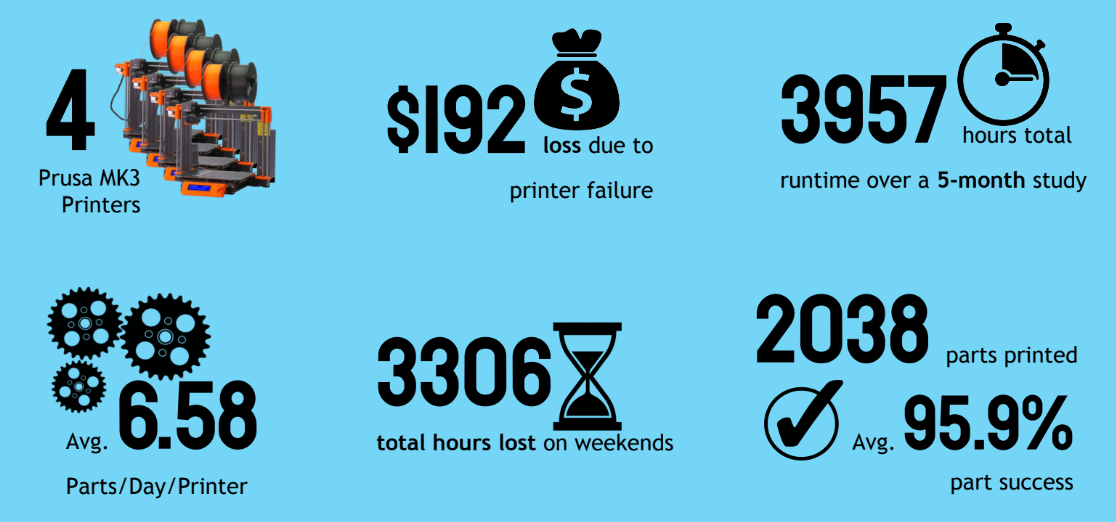ReDeTec Prusa Print Farm Report
ReDeTec uses the production power of Prusa printers to manufacture specific components of our ProtoCycler. As a company that strives to use gathered data to drive logistical improvement, we conducted an analysis on the status and health of our current production printer farm.
We organized our key metrics into three categories:
- Run Times (Part production rate, hours of operation, etc.)
- Failures (Number of failures, most common failure mode, etc.)
- Costs (Cost of each failure mode, cost of maintenance, etc.)
Note that for this report, a “part” refers to one component of an assembly of the ProtoCycler. A “print” is at least one part that is sent to be made by a printer. This analysis took place from January to May, 2022.
Summary

Metric 1: Run Times
A printer was deemed non-operational if it was unable to print parts for at least 1 day (24 hours). Any issues that were fixed within one workday (e.g., through quick maintenance/repairs) did not impact operational uptime.


Some printers were nominally operated for more than 24 hours in a certain day; this is due to the nature of print job tracking, in which a print job is assigned to the day during which it was started. For example, if an 8–hour print was started at 9 AM and subsequently followed by an 18-hour print started at 6 PM, that day would have 26 hours of print time. As a result, the following conditions were added to limit the hours of operation to 24 hours per day:
- If a Monday had more than 15 hours of print time, its print time was reduced to 15 hours.
- If any other weekday had more than 24 hours of print time, it was reduced to 24 hours.
- If the last weekday before the weekend (Friday prior to May 1st, Thursday after May 1st) had more than 24 hours, it was reduced to 24 hours and the additional print time was delegated to the weekend.
Prusa 3 and Prusa 4 saw higher overall usage than Prusa 1 and Prusa 2, although they were primarily used for printing large and complex parts in single-part batches; as a result, Prusa 1 printed the most parts.


Weekend down-times could have been used to print 110 ProtoCycler+ assemblies’ worth of parts.

Metric 2: Failures
A “part failure” occurs when a printed part must be scrapped and re-printed. A “print failure” occurs when at least 1 part fails within a certain print job.

When determining the correlations between failures, “Part Size” defines the volume of the part, and “Part Complexity” is calculated as the ratio between the time required to 3D print the part and the part’s volume.
An additional division factor of 1000 is used to make the resulting value easier to read. This value relies on the assumption that a more complex part will take longer to print, and normalizes all parts by volume to provide a level comparison.



Print jobs with larger batch sizes have inherently higher risks of having at least 1 failed part, since the number of parts that could potentially fail is higher. The 6 - 10 batch size has a very low part failure rate due to the fact that parts printed in that batch size are predominantly of Low complexity, while still being a fairly even mixture of Small, Medium and Very Large sizes. As a result, we get the low failure rates that come with Low complexity parts, without the increase in failure that would come from having predominantly Small parts.

Printer individual part failure rates include all scrapped parts, regardless of why they were scrapped (e.g., geometric inconsistencies, material contamination, etc.). Printer individual print job failure rate tracks the percentage of print jobs that had at least one failure.

Prusa 4 had a very large part failure rate due to two anomalous print jobs in which all parts (14 and 16 parts) were scrapped.

Metric 3: Costs
Below is the actual cost of printer maintenance that occurred during data collection.


Cost of failures includes the additional cost incurred as a result of part failures. These costs include:
- Labour cost of fixing the failure and reprinting the part
- Cost of any replacement components needed to fix the failure’s underlying cause
- Filament cost of reprinting the part
- Electricity cost of reprinting the part

Part Complexity
These graphs highlight ReDeTec’s dedication to design for additive manufacturing. Optimizing parts and print characteristics for production-level 3D printing required significant engineering hours over time, and as a result only a small portion of our total parts are considered to be complex.


Conclusion
Prusa printers are reliable and efficient tools for manufacturing, and the inability to run the farm over the weekend resulted in a loss of valuable printable time. The costs of repair were present, but minimal. Optimizing parts so they are less complex also greatly contributed to the success and efficiency of our production printer farm. Taking the time to design simplified parts and analyze the status of ReDeTec’s setup will help us create a more streamlined, healthy production line.


